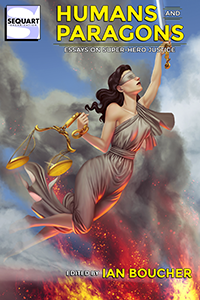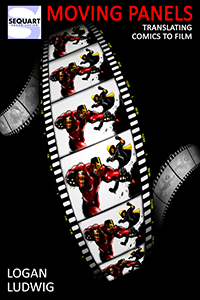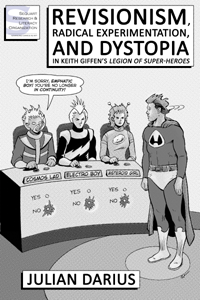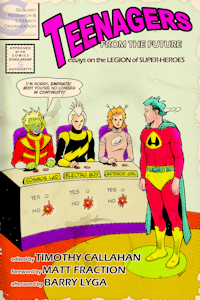Enter, mortals, and despair! This is Tact is for the Weak, the article that’s been eating Mexican food all day and can’t wait to spend the night at your place!
Admittedly, comics fans are a unique breed; to most people, Superman and Captain America are about as significant as Mother Goose, and names like “Magneto,” “Ra’s al Ghul,” and “John Constantine” are only known to most people as Ian McKellen, Liam Neeson, and that guy from “Bill and Ted’s Excellent Adventure.”
…or are they? Ever since Brian Singer’s X-Men movie came out in 2000, there has been a surge of interest in comic books by both Hollywood and the general public. Chances are better than average that the Man On The Street can give you some sort of description of Green Lantern (that guy with the ring), the Flash (the guy in the red suit), Captain America (the dude with the shield), Aquaman (the lame Superfriend), Iron Man (isn’t he a robot? Or maybe it’s armor…), Thor (the Norse Hammer guy!), or Ambush Bug (wait…who?). So what is it about comic books that is so appealing? Is it the variant covers? The cover enhancements? The cover art? Perhaps the amount of gloss on the covers? (In the voice of Emperor Palpatine: Yes, a nice, high-gloss, imprinted, pencils-only variant will do nicely…)
For a deeper look into this cultural phenomenon, one first has to understand how absurd the product actually is. When you get down to it, comics are just books that deprive readers of the opportunity to visualize the characters and events with their own imagination. More often than not, most comics are also written at an easier readability and vocabulary level than “normal” books, and generally focus on the action genre (giving only secondary importance to comedy, mystery, or romance). The subject matter is often dumbed-down to an almost banal level at times, and rarely do comics grab the kind of national attention that many books receive.
“Hey, you’re absolutely right,” you may be saying. “What the hell am I doing reading these dumb funny books? I’m not twelve! It’s time to grow up and move past action figures, Nintendo, and comic books.” Oh, you naive simpleton; this is the exact OPPOSITE of my point. You see, despite all of these generalizations and stereotypes (not to mention the social stigma often attached to comic fandom), there are still millions that defy convention (and, according to come, common sense) by remaining avid enthusiasts-or even casual readers- of comic books.
So what is it about comic books that is oh so attractive? One popular theory is that comic books provide an escapist paradigm shift (I have faith you understood that) to the readers, allowing them to live through the experiences of fantastic characters as they encounter normal and not-so-normal events. Who among us hasn’t wanted to fly or run at the speed of light (or kick on the x-ray vision at the beach)? However, this theory is flawed, in that virtually any fictional medium, be it comics, TV, books, or even old-school radio, can provide the same basic transportation away from our reality and into a fantastic one (I challenge anyone to watch the Lord of the Rings trilogy and not feel like a million bucks afterwards! Or even better: watch Meteor Man. It’s a classic!).
Basically, there is no single thing that makes comic books so appealing (please, write in and tell me why you enjoy them so much! Sharing is caring!). However, to the true, dyed-in-the-wool comic fans, there are two chief qualities that go directly against the comics stereotype: the complexities of the stories and the quality of the artwork.
The quality of comic book stories is one of the best-kept secrets in the world. While there are TV shows being made that document the adventures of underwater sponges or how many African Dung Beetles a person can eat in five minutes (for me, it’s about thirty), comic books have been host to some of the greatest literary minds of our time. Just look at the sudden popularity Alan Moore and Frank Miller are receiving, or how successful Jeph Loeb has been on the Smallville circuit. J.M. Dematties, Warren Ellis, Grant Morrison, Neil Gaiman, Brad Meltzer… the list of legendary comics-writing talent is still growing! Instead of resorting to checking out the latest Ashton Kutcher flick, comics readers have been privy to universe-spanning epics that deal with topics such as vibrational multiverses, mortality, time-travel, religious rationalizations, and some really f***ed-up sh** that straddles the line between super-metaphysical and downright irrational (see Ellis’s Planetary, Morrison’s Animal Man, or basically any Alan Moore comic for some crazy, mind-blowing sh**). How many people at your office can intelligently discuss the possible ramifications and existence of infinite earths?
Complementing the written marvels of comics is the visual package. Free to utilize such basic (but effective) tools as facial expressions, shadowing, and even speech bubble style (i.e.: the notorious “icicle” bubble), writers are free to really elevate their stories to a higher plane of communication and enjoyment (if you’ve never laughed out loud while reading a comic before, check out the Giffen/DeMatteis Justice League run. McGuire’s art alone would have you in stiches!). Few other mediums can compare with the emotional spectrum available to the comic book format; any old-school Justice League fan that says they read all of Identity Crisis #1 without shedding a tear is lying.
Plus, look at the quality of the art! Unlike the cartoony stylings of the “old masters” (such as Will Eisner, Jack Kirby, or Joe Kubert), today’s comic artists have honed their skills to surpass today’s other “legitimate” artists! Take a look at the tremendous quality found in the “classic” and contemporary works of George Perez, John Byrne, Jim Lee, Michael Turner, Ethan van Sciver, Brian Hitch, and many others! I defy you to find me a more widely-beloved living artist than Alex Ross (and remember before you write in that there are millions of Ross fans out there)!
However, in spite of (or perhaps due to) these qualities, ultimately, the most addicting aspect of comic books is their ceaseless continuity and freshness. As with most media, comics evolve with the times around them, but to comic fans, this is so much more than a natural progression. It affords readers the opportunity to see their favorite characters, pillars of morality and heroism, as they confront the ills of the world that we have to contend with day by day. Yes, there is a certain thrill to seeing Green Lantern construct a massive green boxing glove, or watching Wolverine disembowel a group of drug dealer ninja robot pedophiles that so richly deserve their bloody fate (see Wolverine vs. The Drug Dealer Ninja Robot Pedophiles #1-3), but the chance to have a character grow up with you is a special connection that few other forms of entertainment can provide.
However, just as with books, TV, and movies, the comic industry also puts out its fair share of crap. That’s why it’s time for… this week’s Tactless Book of the Week Award!!!
This week, the award goes to… Marvel Comics’s Squadron Supreme #1, by J. Michael Straczynski. Here’s a little history lesson: in The Avengers #70 (1969), writer Roy Thomas “paid homage” to DC’s Justice Society by having the Avengers battle the “Squadron Sinister,” a group comprised of four villains based on Superman, Batman, Flash, and Green Lantern. Then, in 1971, an “unoffical collaboration” took place at DC and Marvel, where the Justice League faced the “Champions of Angor,” a knockoff of The Avengers, and The Avengers battled a fuller “Squadron Supreme,” a heroic version of the “Squadron Sinister” with other additions that ripped off the Justice League. Some of these copycats include Hyperion (Superman), Nighthawk (Batman), The Whizzer (The Flash), Blue Eagle (Hawkman), Arcanna (Zatanna), and Doctor Spectrum (Green Lantern). The powers and backstories of these doppelgangers were almost identical to those of the Justice League, and for years the Squadron played whipping boy to its mistress The Avengers.
Over the years, the group has waxed and waned both in popularity and the degree of seriousness they are given. Hot off of his 18-part rated-mature revamp Supreme Power, J. Michael Straczynski is at it again with a supposedly more legitimate incarnation of these second-stringers. However, one has to wonder: how much merit should one place on characters that were created to spoof the competition? Granted, over the years the Squadron has accumulated a lengthy amount of color and history, but the fact remains that when you boil it down, Squadron Supreme is just Marvel’s flimsy cover story for a chance to play with the Justice League. Unless a radical change happens to the characters, or a slew of new members join, this book will always be a Justice League knockoff, no matter how well-written it is.
And that’s the end of the show, folks! As always, be sure to stop by next week as my tireless tirades continue! Oh, and one more thing: whoever posts the 100th comment (we’ve already doubled the previous Sequart.com record for number of comments!) gets a special mention in my next article! And maybe a strip-o-gram (but don’t bank on it)! Now fly away, children! Fly, fly!


























































